AMAZONからも購入できるようになりました
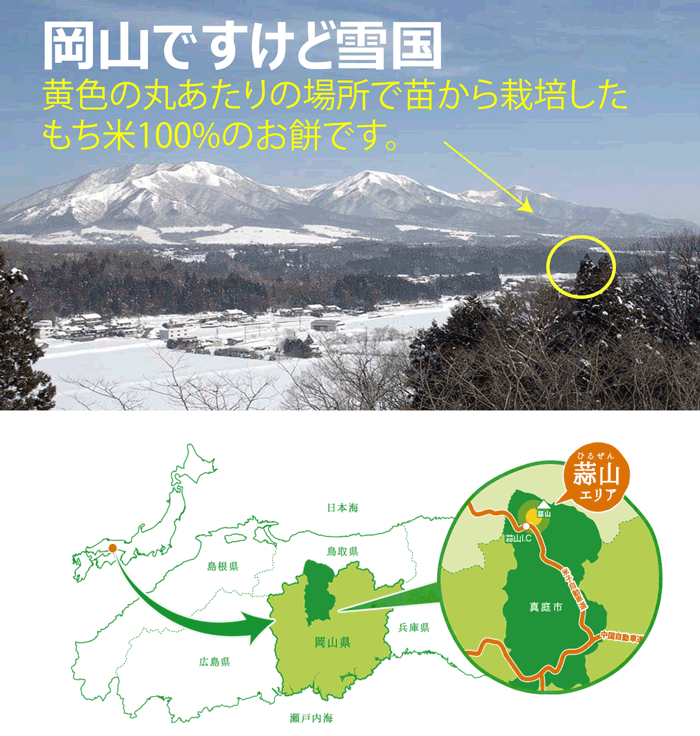

おいしいお餅に欠かせないのが綺麗な水。
中国山地に積もった雪が溶け田を潤します。
水源は「日本名水百選」に選ばれ、夏の避暑地として知られています。
この地域で最も食味が良い(農業団体調べ)といわれる場所でつくった
100%お米のお餅です。

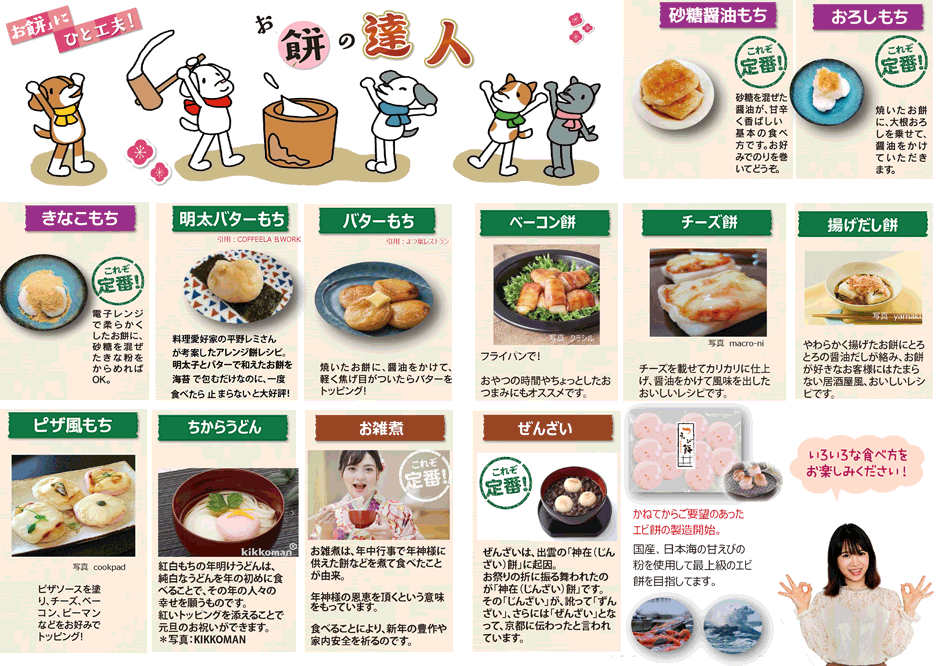
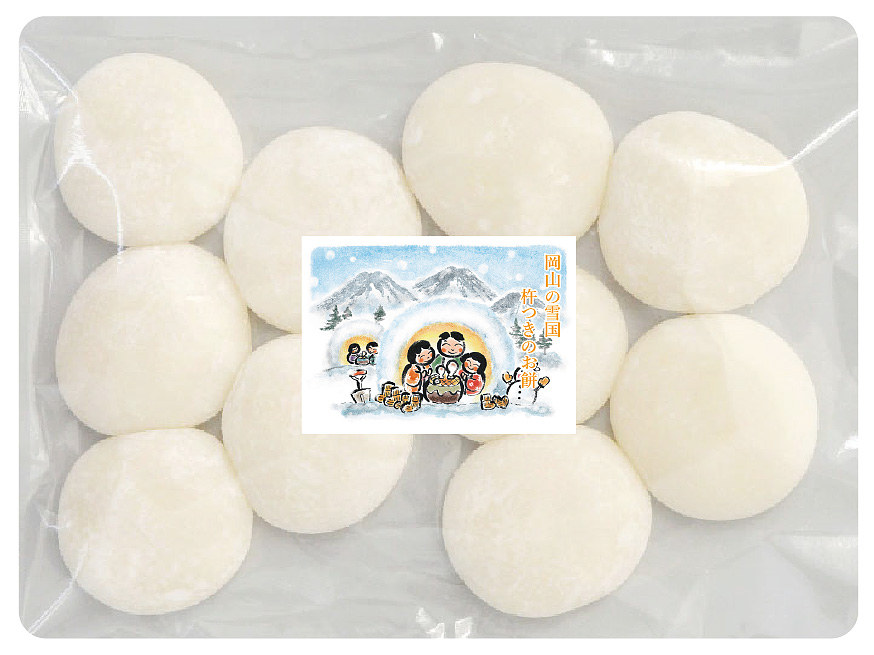
一回り小さな食べやすい・ひとくちサイズ40g/個
100%もち米のお餅
- 煮ても溶け出しにくい冷水栽培もち米のお餅
- 【お正月用生もち】(朝、もちつき、夕出荷)もあります。
- 11月1日~12月24日の間にご注文いただければ、年末(12月25日~12月29日)発送。
高齢者が食べやすい小さなお餅も作っています
|
※通常のお餅の半分の大きさで、飲みこみやすいよう、粘度を2割程度下げ(当園比)、食べやすさと餅本来の食感・味の両立をはかっています。
|
 |
■特徴
|
杵つき餅です
岡山ですけど雪国・気候は東北に似ています
岡山産モチ米100%のお餅
 |
寒冷地のもち米 | 岡山でもスキー場が3つもあり、名水百選の地、きめ細やかな甘みのあるもち米が育つ環境です。
岡山県の最北部に位置し、中国山地のふもと、そこから湧き出る清らかな水、名水百選の地、ひるぜん高原(蒜山高原)で育てられたヒメノモチです。 化学肥料の使用量を5割以上(当園比)減らして栽培したヒメノモチだけでつきあげました。 |
 |
||
 |
食味が特に良い田で栽培 | 岡山県北のひるぜん地域の米は、蒜山米として人気があります。 その中、特に食味が良いと言われる地域で栽培したもち米です。冬には豪雪となる岡山県のひるぜん高原(蒜山高原)は、澄んだ空気やブナの原生林から湧き出る清流に恵まれた、自然豊かな地域。この地の自慢のひとつが、ヒメノモチです。 |
 |
||
 |
できるだけ低農薬での栽培 | 初期生育段階で除草剤を使います。
そして、害虫対策に1回散布するだけの超低農薬栽培です。 ヒメノモチは、「大系227」と「こがねもち」の交配品種として誕生した「もち米」です。 最大の特徴は「白さ」と「コシの強さ」です。お米自体がとても白く、お餅にすると滑らかな食感で際立ってきれいです。 |
 |
||
 |
新鮮なもち米です | もち米を低温倉庫にて保管、ご注文を受けてからお餅にします。
ヒメノモチは、網焼きにして頬張ると甘い香りが口に広がり、お米本来の風味を味わえます。 ひるぜん農園のヒメノモチは、『寒暖差があるので甘みがある』との評価をいただいています。 |

ひるぜん農園 (岡山県真庭市) 鳥取県との境にある高原の町で昭和57年に創立。 【写真は直売店】 |
||
◆お餅はこちらで購入していただけます。
 ひるぜん農園本店3%0ff |
 |
 |
全国のいろいろなお雑煮
| 都道府県 | お雑煮の特徴 | イメージ | |
|---|---|---|---|
| 北海道 | 北海道は、雑煮の種類も多種多様。札幌では主に鶏がらベースで、焼いた角餅が入っています。
|

写真引用:農林水産省 |
|
| 東北 | 青森県 | 青森県の八戸市一部の地域では、くじらの入ったくじら雑煮が食べられています。 | 
写真引用:青森県「お雑煮」JA青森女性部 南地域女性部 |
| 岩手県 | 岩手ではおもちを取り出して“くるみだれ”につけて食べる地域も。 | 
写真引用:ソトコト |
|
| 宮城県 | 宮城県ではハゼの出汁で作る仙台特有の雑煮が有名。 | 
写真引用:パーク味の素 |
|
| 秋田県 | 秋田県内、能代などの地域では比内地鶏を使った鶏ガラスープと「きりたんぽ」を使ったお雑煮。 | 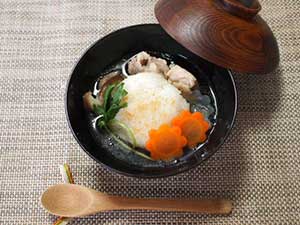
写真引用:あずみ苑 |
|
| 山形県 | 山形県の酒田市や鶴岡市あたりのお雑煮は「丸餅」が一般的。 庄内雑煮は、わらび、こんにゃく、厚揚げなどを具材に、醤油ベースのスープでいただきます。 |

写真引用:楽天レシピ |
|
| 福島県 | 福島県会津地方では、もちをつゆに入れて食べるため、お雑煮ではなく「つゆもち」と呼ばれています。 | 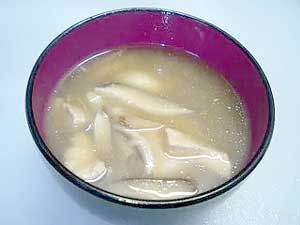
写真引用:gooブログ |
|
| 関東 | 茨城県 | 茨城のお雑煮は、かつおだしをしょうゆで味つけした関東風のすまし汁です。 | 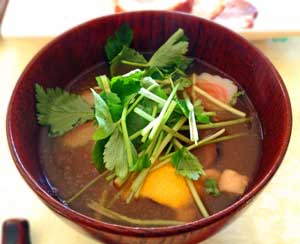 |
| 栃木県 | 栃木のお雑煮は、具だくさんで食べごたえのある「けんちん汁」風です。 | 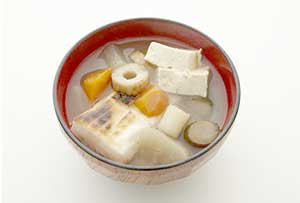
写真引用:Pinterest |
|
| 群馬県 | 群馬のお雑煮は、昆布のだし汁をベースにしょうゆで味をととのえ、具材と角餅を煮て作ります。 | 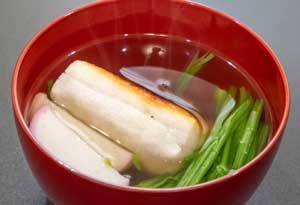 |
|
| 埼玉県 | 埼玉のお雑煮は、関東ならではのかつおと昆布のだしに、濃口醤油の汁でつくります。 | 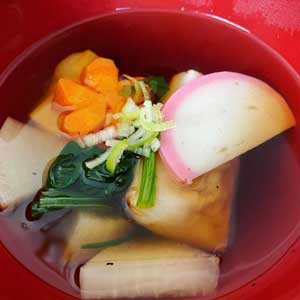 |
|
| 千葉県 | 千葉のお雑煮は、磯の香りがたっぷり香る「はば海苔雑煮」です。 | 
写真引用:dancyu |
|
| 東京都 | かつおと昆布のだし汁に、焼いた角餅が入っています。具材は鶏もも肉、しいたけ、小松菜、にんじん、三つ葉など。醤油、みりんをしっかり効かせるのが特徴。 | 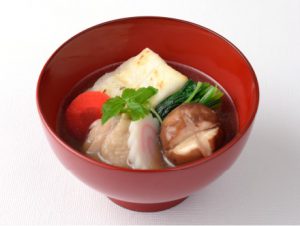
写真引用:農林水産省 |
|
| 神奈川県 | 神奈川は、あっさりとしただし汁に角餅を入れた関東風のお雑煮です。 |  |
|
| 中部 | 新潟県 | 新潟風雑煮の特徴はなんといっても具材。鮭の切り身とイクラ、柚子の皮が入ります。 |  |
| 富山県 | 富山県の魚津市、黒部市のお雑煮は、濃い醤油味で焼き魚が入っています。 | 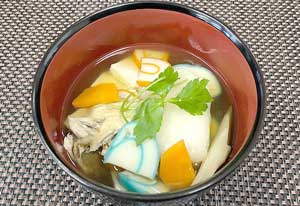
写真引用:みな穂 |
|
| 石川県 | 石川県金沢のお雑煮は焼かない角餅を使い、具も三つ葉かセリ、かまぼこを乗せるのみです。 汁は醤油味のすまし汁です。 |  |
|
| 福井県 | 福井県の「雑煮」は、板昆布を敷いた鍋に水を入れ、丸餅を煮、味噌で味付けをして最後にカツオ節をかけるシンプルなものです。 | 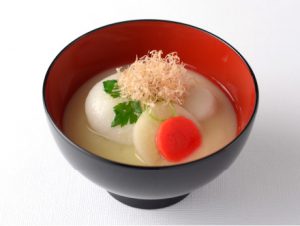 |
|
| 山梨県 | 山梨県のお雑煮は、かつおや昆布、どんこなどのだしをつかいます。 すまし仕立てでちょっと甘めです。 、 |  |
|
| 長野県 | 長野県のお雑煮は角餅を焼いて、かつを出汁のお醤油澄まし汁、具には鶏肉、なると、大根、人参、椎茸、タケノコ、三つ葉にちくわです。 |  |
|
| 岐阜県 | 岐阜県のお雑煮は醤油ベースでおもちと正月菜が基本。お餅は角餅、具はかまぼこくらいでとってもシンプル |  |
|
| 静岡県 | 静岡県のお雑煮は、『関東』 と 『関西』 の特徴を取り込んでいます。 | 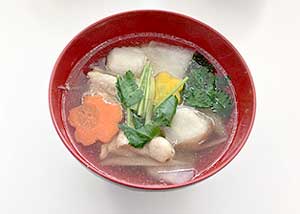 |
|
| 愛知県 | 餅は焼かずに、かつおだしで煮て柔らかくします。具材は餅菜(小松菜の仲間)。醤油、塩で味を調えて、かつお節をのせるだけのシンプルなもの。 | 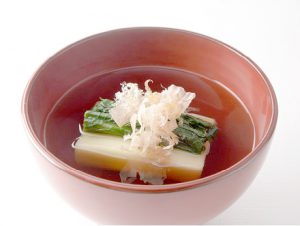
写真引用:農林水産省 |
|
| 近畿 | 三重県 | 三重県のお雑煮は、北勢・伊賀北部・南勢、東紀州ではすまし汁、中勢・伊賀南部では味噌を使うことが多いようです。 |  |
| 滋賀県 | 滋賀のお雑煮は、白みそ仕立てで、煮た丸餅を入れ、大根とサトイモを入れます。 |  |
|
| 京都府 | かつおと昆布だしを使った白味噌仕立て。焼かずに煮た丸餅が入っています。具材は里芋、金時にんじん、大根など。 | 
写真引用:農林水産省 |
|
| 大阪府 | 大阪の商人の家庭では、元旦は白味噌、2日はおすまし仕立てのお雑煮をいただきます。お餅は丸餅で焼きません。 | 
写真引用:農林水産省 |
|
| 兵庫県 | 兵庫県の雑煮は、だいこん、きんときにんじん、 さといもなどの根菜類と鶏肉、かまぼこをだし汁で煮ます。 | 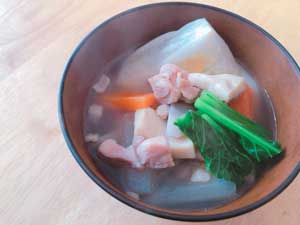 |
|
| 奈良県 | 奈良の雑煮は、椀の餅を箸で汁から取り出し、別皿のきな粉にまぶして食べることます。 お餅は焼いて入れます。 | 
写真引用:ベターホーム |
|
| 和歌山県 | 和歌山お雑煮は、白みそ仕立て、丸餅を焼かずに入れます。 |  |
|
| 中国 | 鳥取県 | 別の鍋で煮た丸餅を、甘い小豆汁に入れたもの。一般的なぜんざいに近いものですが、山陰地方ではこれが雑煮です。 | 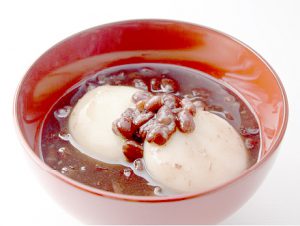
写真引用:農林水産省 |
| 島根県 | 島根県のお雑煮は、2つあります、1つは具に岩のりだけのもの。もう一つは、甘く煮た小豆にもちを入れた小豆雑煮。ぜんざいのようですが、汁がさらりとしているのが特徴。 | 
写真引用:CookPad |
|
| 岡山県 | 岡山県のお雑煮には、ブリを入れるのが特徴です。ほうれん草、紅白のかまぼこをあしらいます。 ブリは表面を焼いてから、沸かしたカツオと昆布の出汁に入れます。 |
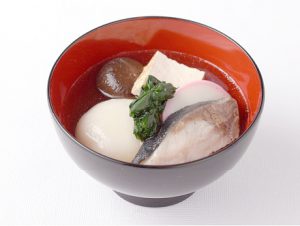 |
|
| 広島県 | 広島県のお雑煮は、蛤・乾物のするめいか・いりこから出汁をとります。かつお・昆布・調味料は入れず、するめいかが味の決め手。 |  |
|
| 山口県 | 山口県のお雑煮は 丸餅にすまし汁です。 |  |
|
| 四国 | 徳島県 | 徳島のお雑煮は地域によって、白みそ仕立て・すまし仕立て、丸もち・角もちなどの違いがあります。 |  |
| 香川県 | いりこのだし汁であん餅を煮て、白味噌で仕立てたもの。具材は里芋、金時にんじん、大根など。あん餅から小豆あんが溶け出して、独特のおいしさに。 | 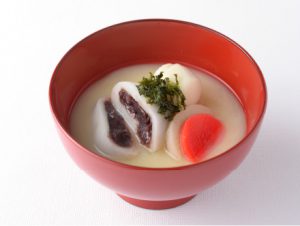
写真引用:農林水産省 |
|
| 愛媛県 | 愛媛県中予のお雑煮は 「澄まし汁仕立て」、「丸もち」、「(お餅は)焼かずに入れる」です。 | 
写真引用:農林水産省 |
|
| 高知県 | もちは角切り、汁はすましが特徴で、もちをだし汁で煮て、もちが柔らかくなったら椀に入れ、茹でておいた水菜と里いもに花かつおの盛り付け。 |  |
|
| 九州 | 福岡県 | 別の鍋で煮た丸餅を、あご(干しトビウオ)のだし汁に入れたもの。具材はブリ、焼き豆腐、かつお菜(高菜の一種)、干ししいたけ、かまぼこなど。 |  |
| 佐賀県 | 佐賀のお雑煮は、スルメイカでだしをとり、レンコンをはじめ色々な野菜が入っています。 | 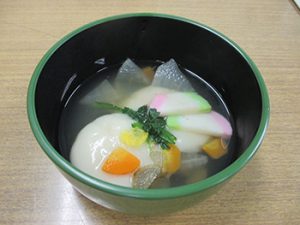
写真引用:JA佐賀市中央女性部 |
|
| 長崎県 | 島原ではお雑煮のことを、「具雑煮」(ぐぞうに)といいます。 具だくさんです。 |

写真引用:あちこち九州 |
|
| 熊本県 | 熊本県のお雑煮は、かつお昆布だしまたはするめだしの、醤油仕立て。 | 
写真引用:シェフごはん |
|
| 大分県 | 大分県のお雑煮は、薄口しょうゆや白味噌。最大の特徴は、餅に「あんもち」を使うことです | 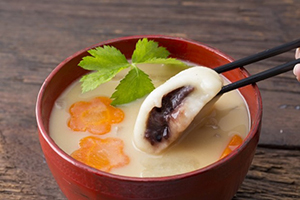
写真引用:COLOCAL |
|
| 宮崎県 | 椎茸ダシお雑煮。 |  |
|
| 鹿児島県 | 鹿児島のお雑煮は「焼きエビ」で出汁を取るのが特徴です。 | 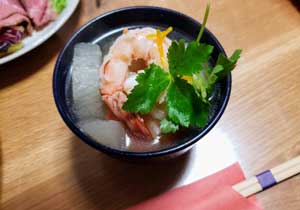 |
|
| 沖縄県 | 沖縄には雑煮を食べる習慣がなく、正月は「イナムドゥチ」という、豚のもつを使った白味噌仕立ての汁物を食べるそうです。 | 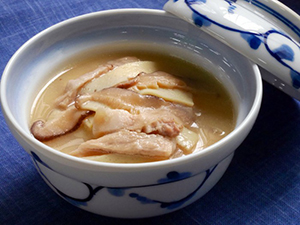
写真引用:サライ |
米粉 国内外レシピ集はこちら ⇒ https://hillzenricefarm.blogspot.com/
レビューを投稿する | |









